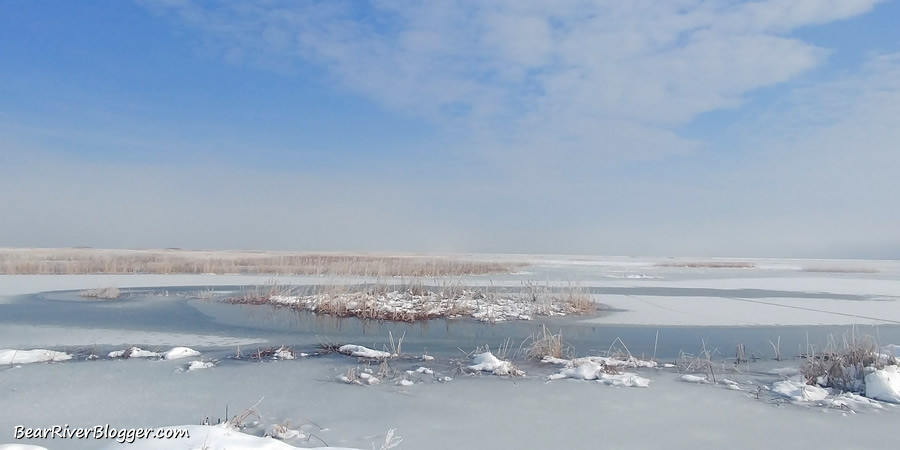Most people who visit the Bear River Migratory Bird Refuge, quietly located in a remote part of northern Utah, understandably come to view some of the hundreds of species of birds that either lives on or migrate through the 77,000-acre wildlife refuge during some part of the year.
It is quite a sight to behold, I will admit, to witness the grand spectacle of migration with countless numbers of birds migrating through this wildlife and nature sanctuary, all heading to a warmer climate for the winter.
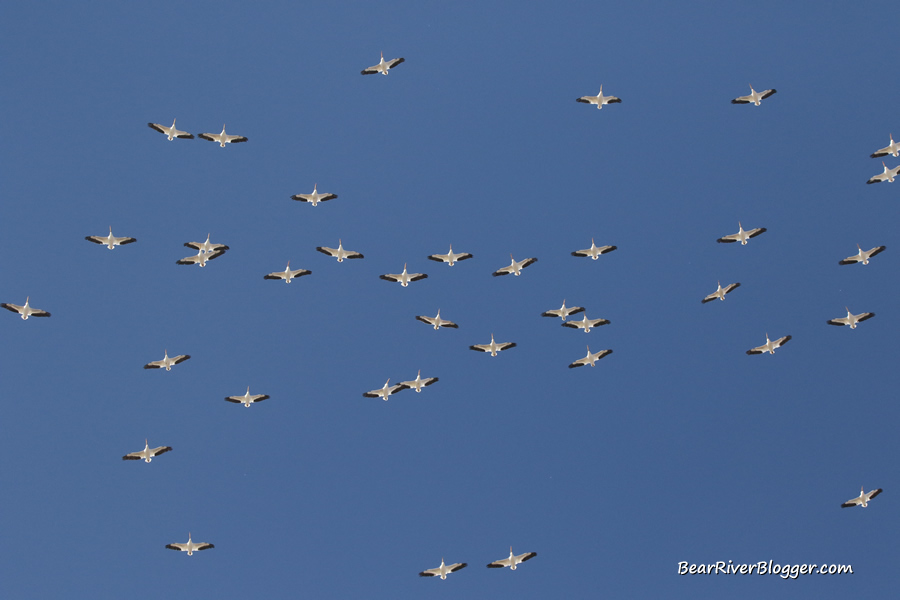
But if all truth be told here, I actually visit the refuge for more than just the birds by themselves.
I come for the experiences. I come to interact with the great outdoors. I come to be a part of the natural world for a short while and to leave behind the chaos of cell phones, deadlines, and traffic jams, all of which can surely overwhelm us if we don’t take time to get away from such things, at least once in a while, and relax for a bit.
Experiencing the natural world first hand, being out in nature in all its grandeur as it were, allows us to do just that, relax. It gives us time to regroup and rejuvenate ourselves, both inside and out, and, in all fairness, this is the biggest reason why I come to the Bear River Migratory Bird Refuge so often.
The dead of winter, in my own personal opinion, is actually the best time of year to experience the bird refuge. It might not have the most birds, and the weather can be rather dreary this time of year, but, in all honesty, the interactions with nature during the dreads of winter are almost a religious experience, of sorts, if you do indeed want them to be as such.
Reread that previous sentence again and you will notice I said “experience” the refuge.
There are certainly better times of year to go bird watching or photographing but keep in mind, however, I am not talking about any of those activities here but rather just referring to the most basic reason we humans like to get out in nature, to experience it on a personal level, maybe even an intimate level, as a whole entity to refresh our most inner selves.
I find this is best done during the deepest, darkest, and coldest part of winter. Yes, winter. The crowds are all but non-existent, and the remaining wildlife oftentimes serves up an up-close and personal experience rarely given during the rest of the year.
Let me give you an example of what I mean from my trip to the Bear River Migratory Bird Refuge yesterday morning, where I spent almost 4 hours driving around the 12-mile auto tour route to see what I could find. I didn’t go with any preconceived expectations but rather just enjoyed what nature gave me along the way.
Allow me to preface my writings here, however, with the disclaimer about the quality of the images taken yesterday and shared here on today’s blog post.
Most of the day, except for a brief moment during the early afternoon, was completely socked in with dense, heavy fog, giving me very low levels of light to work with, which is an outdoor photographer’s worst nightmare, to say the least.
This situation, I am sad to say, led to some extremely poor quality images as my camera struggled a bit in the low light but, nevertheless, I decided to post them anyway to hopefully share and illustrate my experiences more fully.
So please excuse the subpar quality of images on this post. I always try to get the best photos I can, but when the light is very poor, as it was yesterday, I just have to accept the prevailing weather conditions for what they are and remember there will always be another day to photograph again.
Driving the auto tour route
The Bear River Migratory Bird Refuge self-guided auto tour route is 12 miles of pure serenity during winter. This winding gravel road injects itself through the extensive marsh, taking you on a quiet journey of solitude and wonderment.

But the secluded drive is more than just a thoroughfare of sorts, getting us from one place on the refuge to the next. No, the auto tour route, in and by itself, is more than that and is part of the magic the refuge offers during winter to its travelers with great scenery, seductive sounds, and solitude rarely found in our modern world so close to home.
It allows us to actually be a part of nature as we can often times get very close interactions with colorful and animated residents along its curvy path and enjoy beautiful wintery settings along the way.

One such moment yesterday was when I got out of my vehicle and heard a flock of tundra swans whooting somewhere over the frozen, desolate marsh. Despite their great distance aways, just the sound of these tundra swans relaxed me and brought a bit of joy to my day.
Hearing the swans as they tried to navigate through the dense fog allowed me to be a part of their world for a brief and rather most enjoyable moment as they worked their way through a sea of endless haze and fog.
I never could pinpoint their location in the dense curtain of gunk but just knowing they were out there somewhere was more than enough for me.
Winter brings in the rough-legged hawks
My first visual bird encounter along the drive was with a rough-legged hawk. I find these arctic breeding raptors something of a photographic challenge as they oftentimes and so suddenly move from perch to perch in search of rodents.
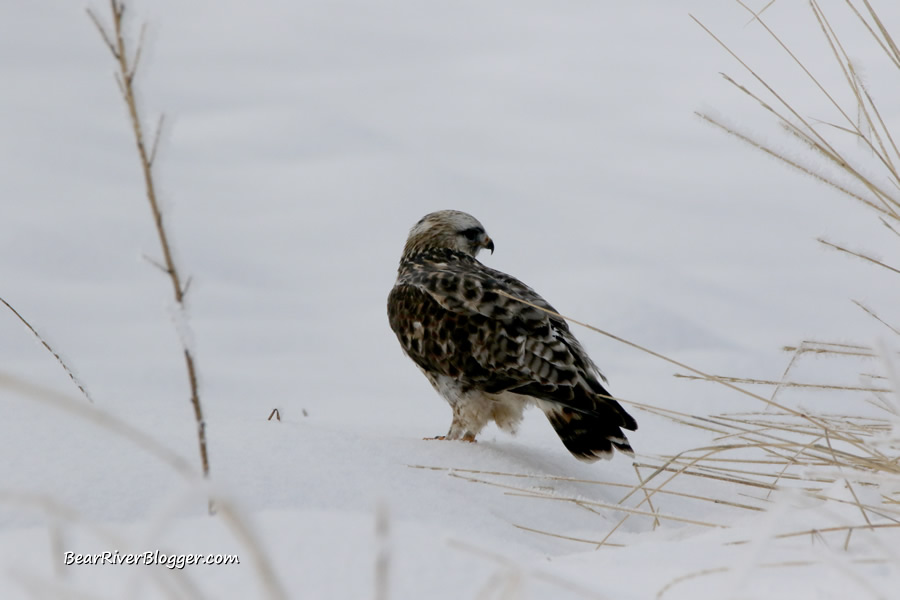
This particular hawk was no exception as, without any apparent reason, he flushed from his icy perch just as my hand reached for the camera. I intently watched him as down the road he flew until something caught his eye, causing the dark brown mottled raptor to abruptly abort his flight by diving into the snow and pulling up a rodent for a quick meal.
Due to the distance at hand, I was unable to photograph the actual hunt, but, however, I was treated to a front-row seat for one of nature’s marvelous performances of instinct and survival.
It is quite a gift to watch a hawk, one that has traveled thousands of miles to get here, act out its part in nature with such precision and grace.
A moment with a song sparrow
Shortly after my encounter with the rough-legged hawk, I came to one of the auto tour loop parking lots where I stopped for a bit, turning off my engine to try and listen for any remaining tundra swans still on the refuge.
Winter has abruptly taken hold of the refuge in a firm, icy grip, and most of the tundra swans, very active and abundant a few days ago, seemed to have left for California since my last visit.

A small but curious song sparrow alongside the vehicle caught my attention as my ears longed for the melodic low-toned whoots of the tundra swan. This handsome little fella was systematically searching the nearby and recently exposed gravel road for seeds.
He seemed unaware of my presence, or maybe he just didn’t care I was only a few feet away, studying his every move through my long lens.
As I sat and watched him gather his meal for the day, I couldn’t help but think about what kind of world this would be if we didn’t have wild places where we can sit and watch birds behave as birds do indeed behave, foraging for seeds on a cold, wintery day.
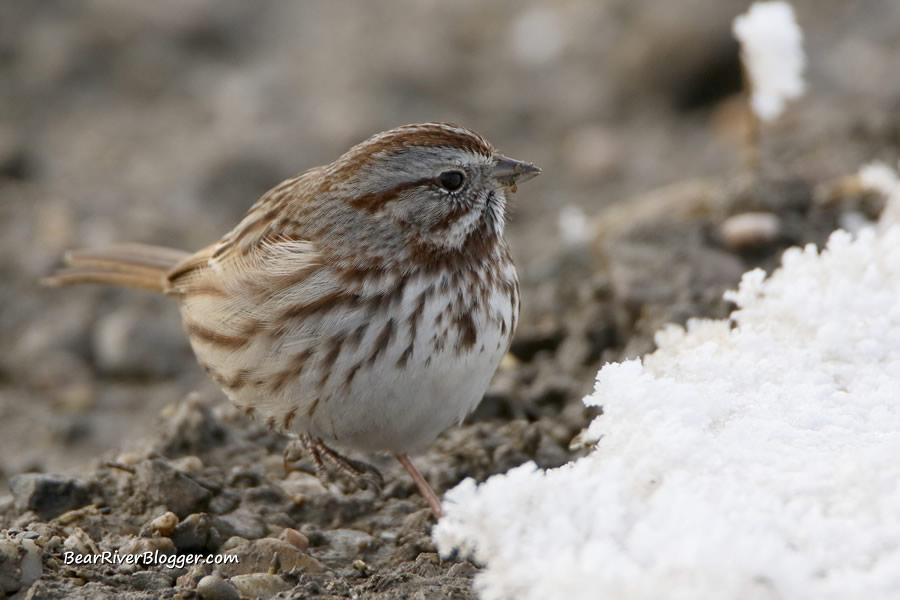
Bird watching, regardless of the time of year, is an opportunity we all can use to sit and enjoy the interactions of nature. It allows time for our minds to rest from our woes for a bit and enjoy the antics of our avian friends.
Red-winged blackbirds
The refuge has a year-round bird I love to watch and photograph any chance I get. The red-winged blackbird sings a most heartwarming melody in the spring but rarely gives us a recital for the rest of the year, including winter.
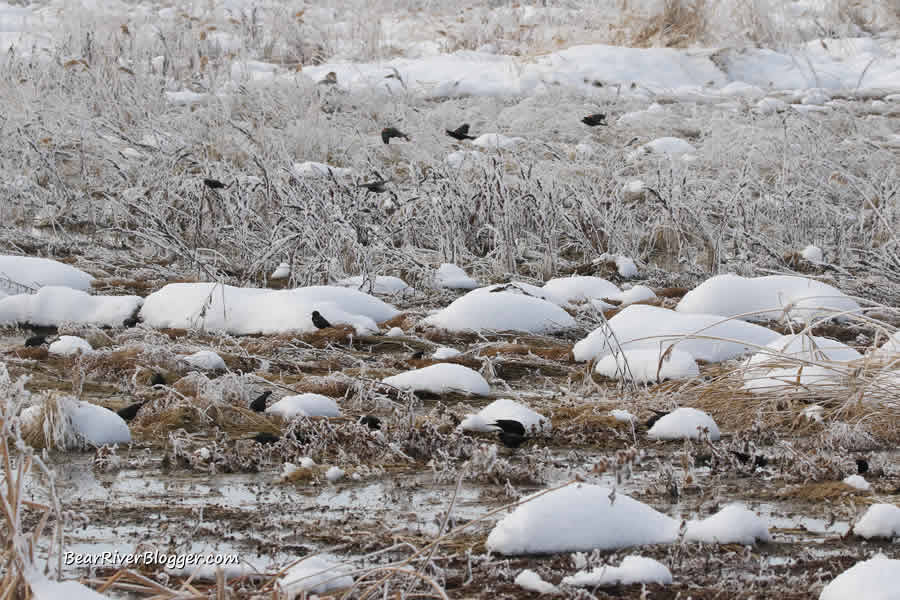
While sitting in the parking lot watching the song sparrow forage for food, I noticed the marsh behind me was flooded with red-winged blackbirds, also foraging for a meal.
A northern harrier buzzed the area, and the skittish birds flushed and left me to think about the fight for survival during winter for the remaining birds on the refuge. It’s a hard time for all, but each actor plays an important part in nature, and winter is a great time to see how the players interact with one another.
As I was leaving the refuge, I took the following picture of a very large flock of red-winged blackbirds feeding in a cornfield that was still standing. Normally a flock of red-winged blackbirds doesn’t cause me to stop so suddenly. But when I saw a yellow-headed blackbird mixed in the large flock, a bird that should have migrated months ago, I was both shocked and surprised.
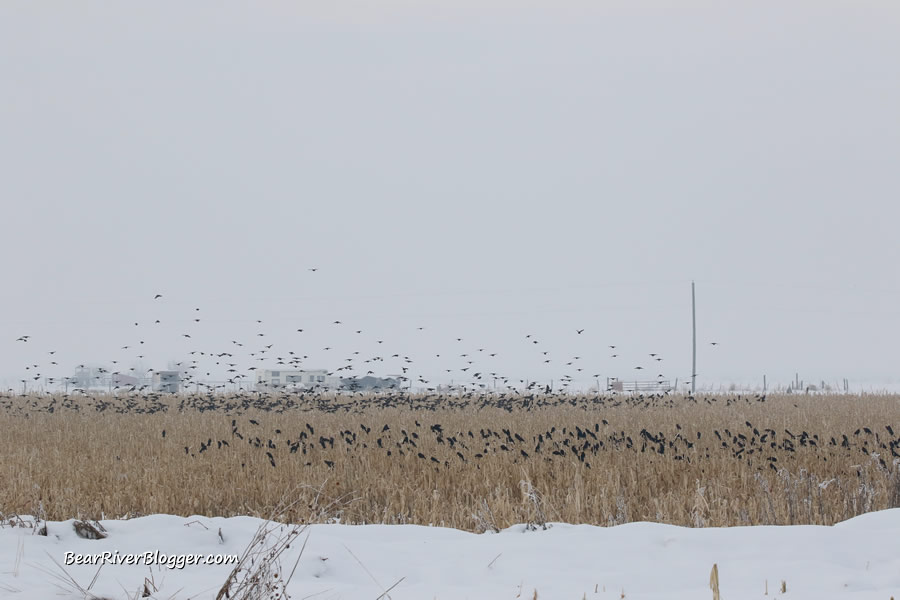
The yellow-headed blackbird is a very common refuge bird during summer, but also one of the first birds to migrate south for the winter. Seeing one this late in the year was a complete surprise, and as I scanned the flock I saw a total of three yellow-headed blackbirds mixed in.
Part of my fascination with birds is seeing unusual sightings such as this.
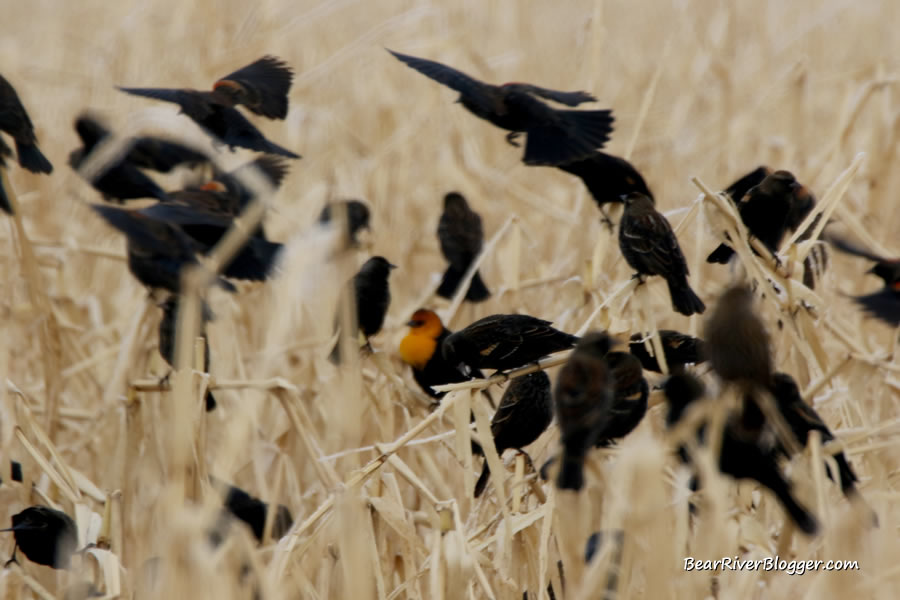
It wasn’t over even as I left the refuge
The auto tour route is only part of the opportunity visitors get to see birds while visiting the Bear River Migratory Bird Refuge. Forest street, the 12-mile road which connects the visitors center to the auto tour route, also has some great birding opportunities, as was shown yesterday while heading back home.
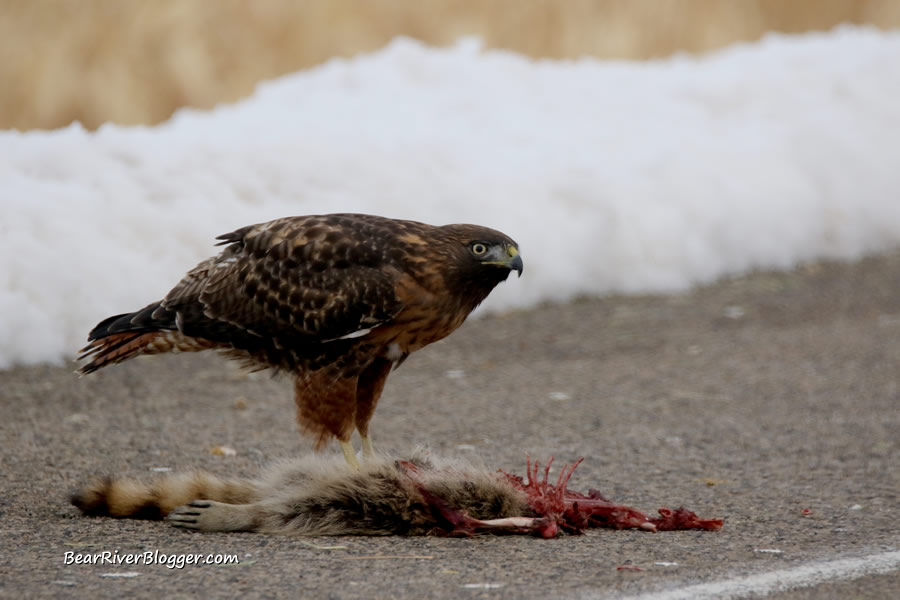
Just before I came across the large flock of red-winged blackbirds, I spotted a large bird in the road. A redtail hawk had chased off some hungry ravens that were now impatiently standing off to the side. The large raptor had confiscated the dead raccoon laying on the side of the road and was taking his turn at the carcass.
I could tell both the hawk and ravens were anxious to feast on the meal, but there was a distinct hierarchy of ownership by the redtail as he calmly ate his portion.
A few minutes later, I watched another redtail hawk swoop down from a telephone pole to lay capture to an unsuspecting mouse. I see redtails daily in this area, but rarely have I seen one successfully come up with a meal, especially when I was just a few short yards away.
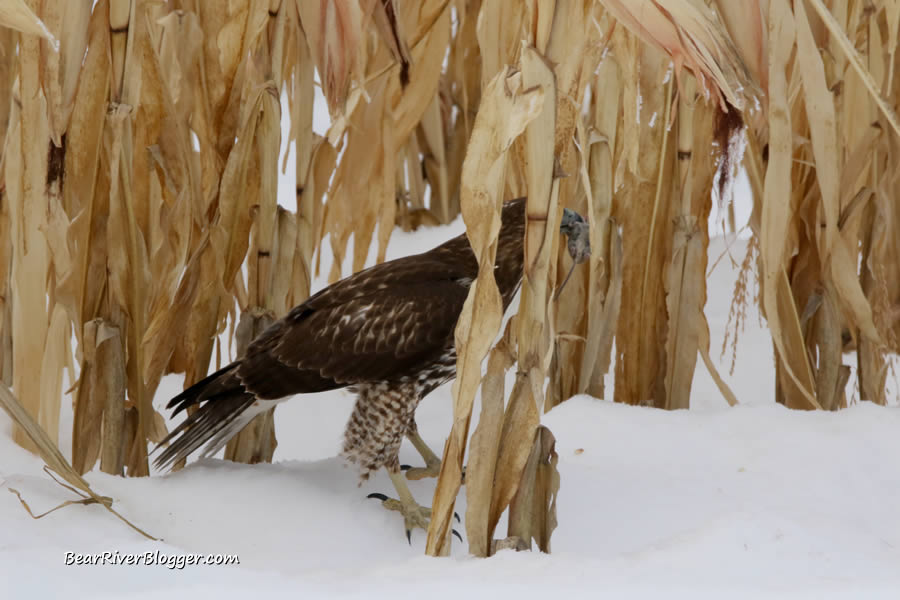
This was both a sight to see and a quite frustrating moment as well since the low light really hurt the quality of the images. I have never had an opportunity to photograph a redtail so close before with a mouse in hand, but even though the images were awful in quality, the interaction from watching a redtail hunt was quite spectacular.
The last bird I came across on my trip was a western meadowlark perched on a corn stalk. This has to be one of my all-time favorite birds to watch, photograph, and listen to during spring.

The refuge has western meadowlarks on it during summer, but most of them move off to surrounding farm areas and roadsides to make a humble living during winter.
Even though I had seen all of these birds hundreds of times before, just watching them interact with nature all by myself on such a cold, wintery day was most relaxing.
For me, winter truly is a grand time to go bird watching and to just sit and enjoy nature.
It offers sights and sounds not often seen during the rest of the year and today was certainly no exception.
Feel free to sign up and follow my blog about nature on and off of the Bear River Migratory Bird Refuge. Nature is my passion, and it is my goal to help show you why I love it so much so you can enjoy it as well.
